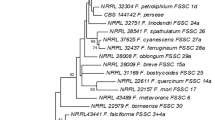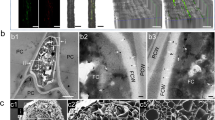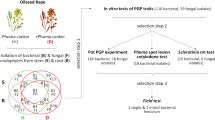Abstract
EVERY Gasuarina equisetifolia plant examined has beenfound to have mycelia of Phomopsis casuarince F. Tassi extending throughout into every organ, beginning from theseed-coat. Cutting a section of the seed-coat of Gasuarina and staining in picro-nigrosin or cotton blue one cansee finely branched and septate hyphae within the tegmen(see accompanying illustration). Only the resting embryowith two cotyledons is free from fungal infection. In samples of tomato and apple seeds from some apparently healthy fruits from Calcutta markets, I have seen a networkof copiously branched and septate hyphse in the tegmen under the microscope. Dennis1 recently remarked that “fungi capable under favourable circumstances of parasitizing economic plants such as potato, tomato and apple may be found in nature as saprophytes on herbaceous weeds ”. I wonder whether Dennis had examined microscopically sections of clean seeds of the various economic plants to locate any possible Phoma hyphae within the tegmen beforeplanting them in the virgin soil. Oxley and Jones2 found, under the epidermis of maize seeds and seeds of many samples of English wheat and some Canadian wheat, abundant mycelia in the vegetative condition which they have not been able to identify nor to bring out in pure culture. In some samples of local wheat and maize seeds and some American maize, I have also obtained distinctly septate and branched hyphse beneath the testa within the tegmen ; from a maize sample Ascochyta sp. has been isolated in pure culture in malt agar tube, the seed germinated well in the course of five days and the fungus came out with two-celled, oblong and muticate conidia. Bessey3 andDennis1 regard Ascochyta as essentially a Phoma with two-celled conidia. It would be of interest to know the function of these hyphse within the seed coat, whether theyhave any connexion with germination and growth of the wheat and maize plants.
This is a preview of subscription content, access via your institution
Access options
Subscribe to this journal
Receive 51 print issues and online access
$199.00 per year
only $3.90 per issue
Buy this article
- Purchase on Springer Link
- Instant access to full article PDF
Prices may be subject to local taxes which are calculated during checkout
Similar content being viewed by others
References
Gosselin, R., Farlowia, 1, 525 (1944).
Melin, E., "Tree-Mycorrhiza" (English translation) (Ann. Arbor, Michigan, 1930).
Dennis, R. W. G., Trans. Brit. Mycol. Soc., 29, 11 (1946).
Oxley, T. A., and Jones, J. D., Nature, 154, 826 (1944).
Bessey, E. A., "Text Book of Mycology" (Philadelphia, 1935).
How, J. E., Ann. Bot., New Ser., 5, 121 (1941).
Hahn, G. G., Mycologia, 35, 112 (1943).
Shear, C. L., and Wood, A. K., U.S. Dept. Agric, Bur. Plant Indust. Bull. 252 (1913).
Campbell, W. A., et al., Tech. Bull. 785, U.S. Dept. Agric. 1 (1942).
Strasburger, "Text Book of Botany" (6th English Edition) (London 1930).
Parkin, E. A., Ann. Appl. Biol., 29, 268 (1942).
Blake, A., Oxford Forestry Mem., No. 14, 5 (1932).
MacDougal, D. T., and Dufrenoy, J., Plant Phys., 19, 440 (1944).
Author information
Authors and Affiliations
Rights and permissions
About this article
Cite this article
BOSE, S. HEREDITARY (SEED-BORNE) SYMBIOSIS IN CASUARINA EQUISETIFOLIA forst. Nature 159, 512–514 (1947). https://doi.org/10.1038/159512a0
Issue Date:
DOI: https://doi.org/10.1038/159512a0
This article is cited by
-
Rhabdocline needle cast—investigations on various Douglas fir tissue types
European Journal of Plant Pathology (2013)
-
Problem of Wheat-Rust
Nature (1950)
-
Latent Infection in Coffea arabica L.
Nature (1948)
Comments
By submitting a comment you agree to abide by our Terms and Community Guidelines. If you find something abusive or that does not comply with our terms or guidelines please flag it as inappropriate.



